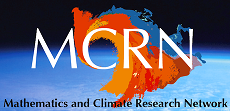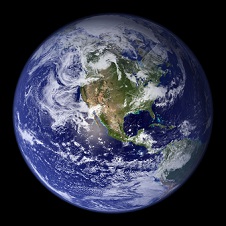|
MCRN-MN Mathematics of Climate Seminar |
 |
Spring 2019 Schedule
February 5, 2019
Filippov Systems and Multiflows, Cameron Thieme, School of Mathematics
February 12, 2019
Modeling the mice microbiome using a generalized Lotka-Volterra equation, Somyi Baek, School of Mathematics
February 26, 2019
Habitat loss, extinction debt, and opportunities for restoration, Kate Meyer, School of Mathematics
March 5, 2019
Effects of Eccentricity on Climate and Habitability, I, Harini Chandramouli, School of Mathematics
March 12, 2019
Effects of Eccentricity on Climate and Habitability, II, Harini Chandramouli, School of Mathematics
April 30, 2019
Modeling the Mid Pleistocene Transition in a Budyko-Sellers Type Energy Balance Model using the LR04 Benthic Stack Somyi Baek, School of Mathematics
A conceptual model of the Plio-Pleistocene glacial cycles is developed based on the Budyko-Sellers type energy balance model. The model is shown to admit a phenomenon like the Mid-Pleistocene transition, capturing the essence of the albedo and the temperature precipitation feedbacks. In this talk, I will give a brief discussion of the model as well as how the LR04 benthic stack was utilized in the making of the model.
May 7, 2019
Effects of a Rogue Star on Earth's Climate Harini Chandramouli, School of Mathematics
Consider a star passing through our solar system "close enough" to disturb the orbital elements of Jupiter. We will look at how Jupiter's orbital elements change as time progresses from the past to the future. Changes in Jupiter's orbital elements could lead to potential changes in Earth's orbital elements and hence Earth's climate. We wish to study the effects of this passing star on Earth's climate and try to see if any past climate data matches with such an event happening.
May 14, 2019
Permafrost melt and its effects on planetary energy balance Kaitlin Hill, School of Mathematics
In the Northern hemisphere, permafrost sequesters large reservoirs of carbon. Upon melting, these carbon reserves may contribute strongly to increases in global mean temperature through the positive carbon feedback associated with permafrost melt, carbon release, and temperature increases. In this talk, we will analyze the effect of permafrost melt on global energy balance from a conceptual point of view. By considering changes in soil temperature as heat conduction, we may explicitly couple an expression for soil temperature at each latitude with Budyko's model for surface temperature. We will discuss possible motifs for analyzing the effect of permafrost on global energy balance and the insight each motif can provide into the dynamics of the system.
